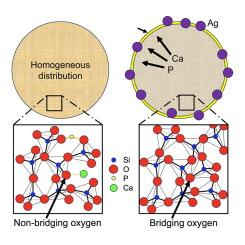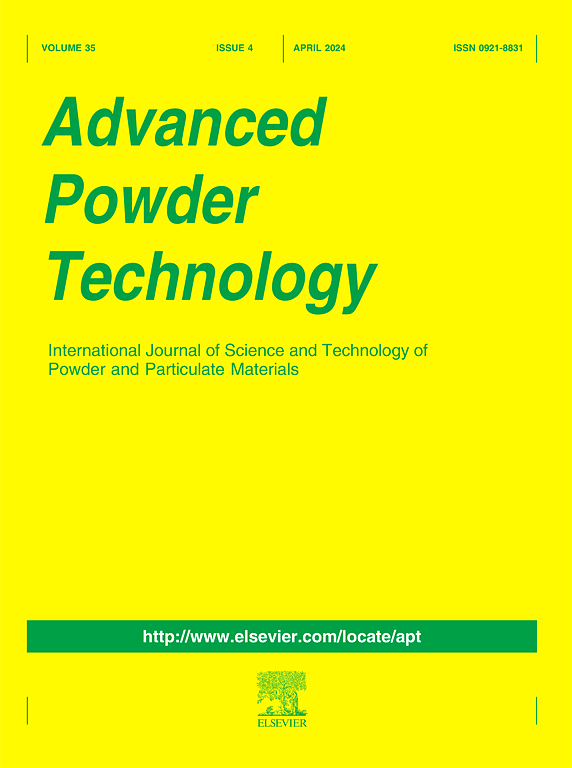Heterogeneous amorphous structure and bioactivity in silver-doped bioactive glasses synthesized by spray drying methods
IF 4.2
2区 工程技术
Q2 ENGINEERING, CHEMICAL
引用次数: 0
Abstract
In this study, Ag-doped SiO2-CaO-P2O5 bioactive glasses (BGs) were synthesized by a spray drying method, and their atomistic structures were investigated by transmission electron microscopy, X-ray diffraction, and nuclear magnetic resonance. The constituent elements (Si, Ca, P, and O) were homogeneously distributed in the pure (non-doped) BG, but a small Ca- and P-rich layer was present on the surface. The segregation of Ca and P on the surface became more pronounced with increasing Ag concentration. The atomic pair-distribution functions extracted by nanobeam electron diffraction revealed that the Ag-doped BG particles had a heterogeneous amorphous structure: the interior and surface of the BG particles were similar to those of SiO2 and phosphate-based glasses, respectively. The addition of Ag resulted in less non-bridging oxygen, which may be due to the removal of the network modifier ion (Ca) from the SiO2 network. In vitro bioactive tests of the pure BG and Ag-doped BG particles revealed that the formation of hydroxyapatite was enhanced by Ag doping, although the amount of non-bridging oxygen decreased. This is attributed to the P- and Ca-rich surface layer, which triggers the nucleation and growth of hydroxyapatite.

喷雾干燥法制备掺银生物活性玻璃的非均质非晶结构和生物活性
本研究采用喷雾干燥法制备了掺银SiO2-CaO-P2O5生物活性玻璃(BGs),并利用透射电镜、x射线衍射和核磁共振对其原子结构进行了表征。组成元素(Si, Ca, P和O)均匀分布在纯(未掺杂)BG中,但表面存在一个小的富Ca和P层。随着银浓度的增加,表面Ca和P的偏析更加明显。纳米束电子衍射提取的原子对分布函数表明,掺杂ag的BG颗粒具有非均质无定形结构,其内部和表面分别与SiO2和磷酸盐基玻璃相似。Ag的加入导致非桥氧减少,这可能是由于从SiO2网络中去除了网络改性剂离子(Ca)。纯BG和Ag掺杂BG颗粒的体外生物活性试验表明,Ag掺杂增强了羟基磷灰石的形成,尽管非桥接氧的数量减少了。这是由于富磷和富钙的表层触发了羟基磷灰石的成核和生长。
本文章由计算机程序翻译,如有差异,请以英文原文为准。
求助全文
约1分钟内获得全文
求助全文
来源期刊

Advanced Powder Technology
工程技术-工程:化工
CiteScore
9.50
自引率
7.70%
发文量
424
审稿时长
55 days
期刊介绍:
The aim of Advanced Powder Technology is to meet the demand for an international journal that integrates all aspects of science and technology research on powder and particulate materials. The journal fulfills this purpose by publishing original research papers, rapid communications, reviews, and translated articles by prominent researchers worldwide.
The editorial work of Advanced Powder Technology, which was founded as the International Journal of the Society of Powder Technology, Japan, is now shared by distinguished board members, who operate in a unique framework designed to respond to the increasing global demand for articles on not only powder and particles, but also on various materials produced from them.
Advanced Powder Technology covers various areas, but a discussion of powder and particles is required in articles. Topics include: Production of powder and particulate materials in gases and liquids(nanoparticles, fine ceramics, pharmaceuticals, novel functional materials, etc.); Aerosol and colloidal processing; Powder and particle characterization; Dynamics and phenomena; Calculation and simulation (CFD, DEM, Monte Carlo method, population balance, etc.); Measurement and control of powder processes; Particle modification; Comminution; Powder handling and operations (storage, transport, granulation, separation, fluidization, etc.)
 求助内容:
求助内容: 应助结果提醒方式:
应助结果提醒方式:


